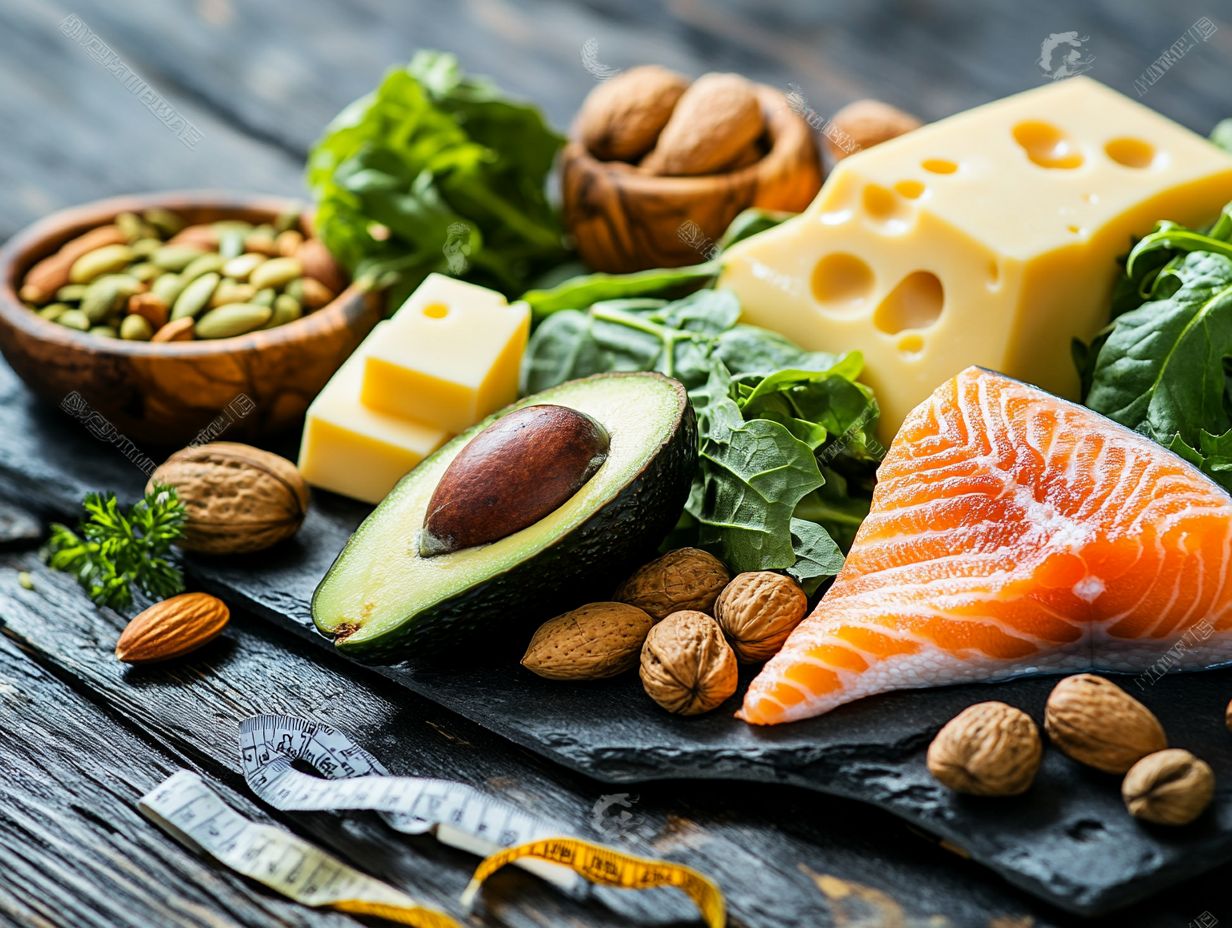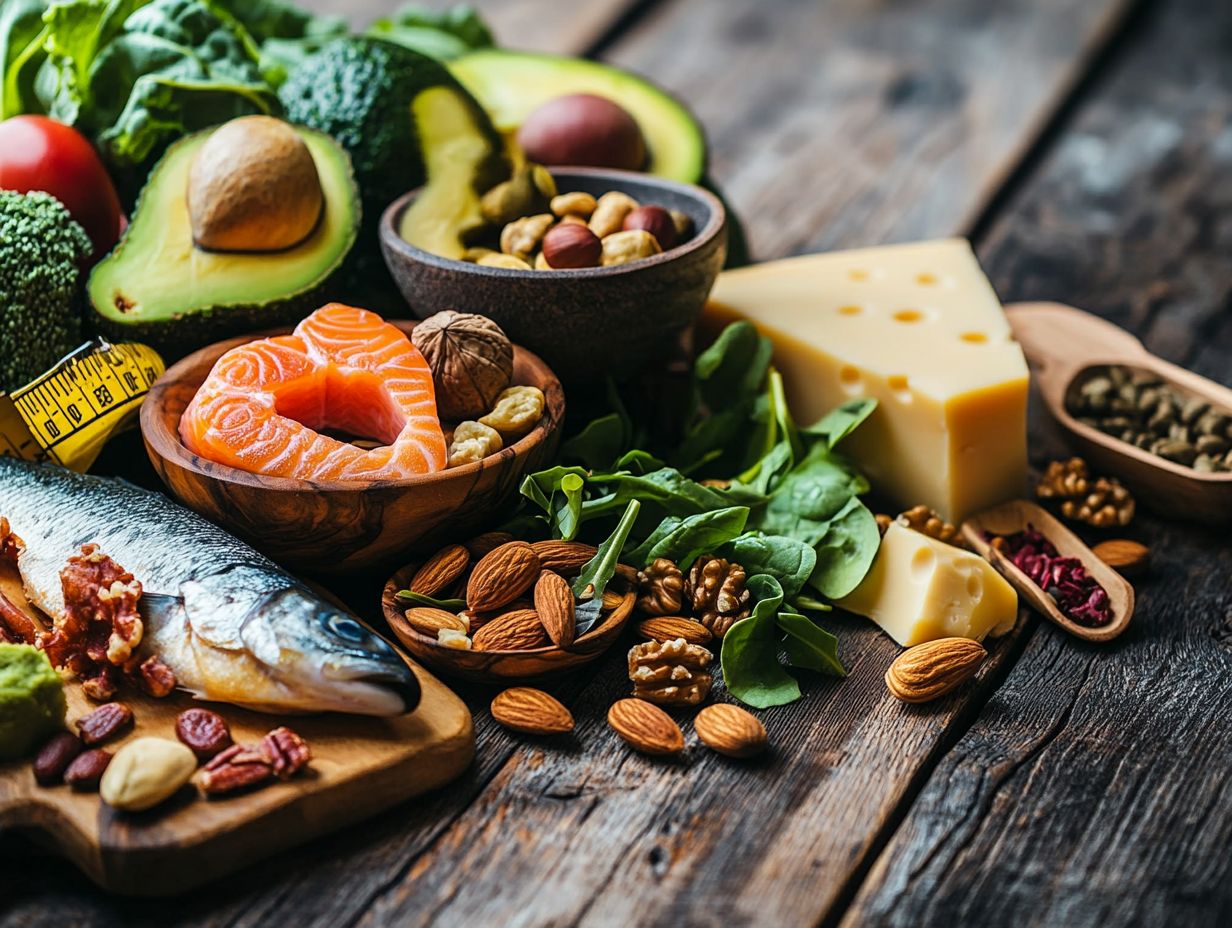Nutritional Strategies for Keto Success
Discover how the Keto diet can change your life! The Keto diet, a well-known low-carbohydrate diet, has become exceptionally popular for its remarkable potential to transform your health and wellness.
But what precisely is this low-carb, high-fat eating plan, also known as a ketogenic diet, and how does it work for you?
This exploration will delve into the foundations of the Keto diet. We will uncover the science behind its effectiveness and the many benefits it can provide. These benefits range from weight loss and improved blood pressure to increased energy levels.
It offers many advantages, but it also comes with certain risks, such as nutrient deficiencies and digestive issues. Therefore, we will address potential pitfalls and discuss nutritional strategies that will help you achieve success on your Keto journey.
Unlock the keys to thriving on the Keto diet, securing long-term results, and understanding the important dietary guidelines that truly matter.
Contents
- Key Takeaways:
- What Is the Keto Diet?
- How Does the Keto Diet Work?
- What Are the Benefits of the Keto Diet?
- What Are the Potential Risks of the Keto Diet?
- Nutritional Strategies for Keto Success
- What Are Some Tips for Long-Term Success on the Keto Diet, Including Managing Appetite Hormones and Metabolic Effects?
- Frequently Asked Questions
- What is the keto diet and how does it work for weight loss?
- Can anyone follow a keto diet for weight loss?
- What are some key nutritional strategies for success on the keto diet?
- Can I still eat vegetables on the keto diet?
- Is there any risk of nutrient deficiencies on the keto diet?
- How long does it take to see results on the keto diet?
Key Takeaways:

- To succeed on the keto diet, eat a variety of non-starchy vegetables and high-quality proteins, ensuring optimal nutrient intake.
- Staying hydrated, maintaining electrolyte balance, and being mindful of micronutrient intake can help avoid potential risks like keto flu and digestive issues, leading to optimal results on the keto diet.
- Long-term success on the keto diet can be achieved through meal planning and prep, finding keto-friendly alternatives, and listening to your body’s needs and signals, thus preventing weight loss plateaus and food cravings.
What Is the Keto Diet?
The ketogenic diet, commonly known as the keto diet, is a simple low-carbohydrate approach that prioritizes high-fat and adequate protein intake while sharply reducing carbohydrate consumption to achieve a state called ketosis.
In this state, your body becomes remarkably efficient at burning fat for energy, shifting away from glucose as its primary fuel source. This transition can unlock many health benefits and serve as an effective strategy for weight loss.
Many individuals opt for the keto diet not solely for shedding pounds, but also for its potential positive impact on insulin resistance, diabetes, and various health conditions such as epilepsy and Alzheimer s disease.
How Does the Keto Diet Work?
The ketogenic diet operates by significantly cutting back on carbohydrate intake, guiding your body into a metabolic state known as ketosis. In this state, fat becomes your primary energy source, replacing your glucose supply.
This transformation not only aids in creating a calorie deficit but also enhances insulin sensitivity and reduces insulin levels factors that can be vital for anyone dealing with insulin resistance and other metabolic changes.
What Are the Benefits of the Keto Diet?
The benefits of the ketogenic diet are abundant and extend well beyond mere weight loss. You may find that improved blood sugar control, increased energy levels, and enhanced mental clarity accompany the metabolic state achieved through the ketosis process.
These health advantages can be especially valuable for individuals grappling with obesity, diabetes, and other metabolic disorders like heart disease and cancer, ultimately guiding you toward a more balanced and fulfilling lifestyle.
1. Weight Loss
Weight loss stands out as one of the most celebrated advantages of the ketogenic diet. This is primarily achieved through a calorie deficit and the appetite suppression that the diet’s high-fat content fosters. It promotes fat adaptation over time, ensuring you effectively burn stored fat.
As you transition into a state of ketosis, your body becomes remarkably adept at burning stored fat for energy instead of relying on carbohydrates. This shift aids in reducing your overall body fat percentage and enhances how your body uses energy by stabilizing insulin levels and improving energy utilization. Tracking your blood ketone levels can help monitor this.
The ketogenic diet also influences appetite hormones like ghrelin and leptin, effectively curbing your hunger and leading to a reduced calorie intake. This is an important aspect of managing your food environment and choices.
To successfully navigate this dietary journey, you can benefit greatly from meticulous meal planning and calorie tracking. Focus on nutrient-dense whole foods and maintain consistency to ensure compliance. It’s also vital to steer clear of potential pitfalls such as food cravings and nutrient deficiencies.
2. Improved Blood Sugar Control
Improved blood sugar control is another significant advantage of the ketogenic diet, particularly for those grappling with insulin resistance or diabetes. By adhering to a low carbohydrate intake, you stabilize your glucose levels and reduce your reliance on insulin for managing blood sugar.
This dietary approach encourages your body to enter a state of ketosis, where fat takes the spotlight as the primary energy source instead of carbohydrates. Research has shown that this shift lowers insulin levels and enhances insulin sensitivity, making it easier for your body to regulate blood sugar effectively and mitigating risks associated with diabetes.
A study published in the journal ‘Diabetes Therapy’ revealed that participants following a ketogenic diet experienced a notable decrease in their hemoglobin A1c levels, a crucial indicator of long-term blood sugar control. Another investigation highlighted how individuals with type 2 diabetes reported significant weight loss and improved metabolic markers. This reinforces the ketogenic diet’s potential in managing diabetes and enhancing overall metabolic health. Consulting a registered dietitian can further optimize these benefits.
3. Increased Energy and Mental Clarity
Many followers of the ketogenic diet report experiences of heightened energy levels and improved mental clarity. This can be attributed to the brain’s remarkable ability to use ketones as a more efficient energy source during fasting periods. Ketones deliver a steady stream of fuel without the rollercoaster of spikes and crashes that come with carbohydrate consumption.
Transitioning from glucose to ketones not only stabilizes your energy levels throughout the day but also helps reduce fatigue, which is particularly beneficial for maintaining focus during demanding tasks. By nurturing a state of fat adaptation, you may discover that your productivity improves as your body becomes adept at converting stored fat into usable energy. This process enhances cognitive functions, allowing for quicker information processing and sharper decision-making.
Consequently, the ketogenic diet can be a powerful ally in boosting both physical endurance and mental sharpness. This offers an appealing option for anyone looking to adopt a holistic approach to health and performance, especially through ketogenic foods and recipes.
What Are the Potential Risks of the Keto Diet?

The ketogenic diet presents an array of benefits you may find appealing, yet it also carries potential risks that warrant your attention. Among these are the possibility of nutrient deficiencies and health complications stemming from strict dietary restrictions, often referred to as ‘keto flu’ during the initial adjustment phase. Ensuring dietary compliance and monitoring nutrient intake are key to managing these risks.
It’s essential to navigate this path with awareness and care.
Now is the perfect time to explore how the ketogenic diet can enhance your health! Consider consulting with a healthcare professional to start your keto journey.
1. Nutrient Deficiencies
Nutrient deficiencies can sneak up on you while following a ketogenic diet if you don t meticulously plan your meals to incorporate a diverse array of foods that are rich in essential vitamins and minerals. This oversight could lead to potential health complications over time. Consulting dietary resources can help in planning balanced meals.
To mitigate this risk, it’s vital for you to focus on key nutrients such as magnesium, potassium, and fiber, which often take a backseat in low-carb food selections. By incorporating dark leafy greens, avocados, nuts, and seeds into your daily meals, you can effectively address these nutritional needs. Planning meals that pair protein sources with vegetables not only enhances nutrient absorption but also creates a satisfying culinary balance. Referencing ketogenic recipes can aid in achieving this balance.
Employing meal prep strategies, such as batch cooking or creating a weekly menu, can simplify your efforts, ensuring you consistently enjoy a variety of nutrient-dense foods.
2. Keto Flu
Keto flu refers to a collection of temporary symptoms that you might encounter during the initial adjustment phase of the ketogenic diet. You may experience headaches, fatigue, and irritability as your body transitions into a new metabolic state, adapting to carbohydrate restriction.
These symptoms usually kick in within the first week after you start the diet and can linger anywhere from a few days to over a week, depending on your previous eating habits and how effectively you adapt to the significant cut in carbohydrate intake.
It’s crucial to stick to low-carb options and steer clear of high-sugar foods. Staying well-hydrated and ensuring you get enough electrolytes like sodium, potassium, and magnesium can significantly ease the discomfort linked to keto flu, supporting your body during this metabolic shift and minimizing health complications.
Take these proactive steps, and you’ll conquer those initial hurdles with ease! By following these guidelines, you ll likely settle into your new diet much more smoothly.
3. Digestive Issues
You may find yourself facing some digestive issues when making the leap to a high-fat ketogenic diet. This often stems from the significant changes in dietary fats and the inclusion of sugar alcohols, which can lead to gastrointestinal discomfort. Such issues highlight the importance of appropriate food choices and food variety.
You might experience symptoms ranging from constipation to diarrhea, adding an extra layer of challenge to your transition. To ease these digestive disturbances, it s essential to incorporate fiber-rich, non-starchy vegetables into your meals, thus adhering to dietary guidelines.
Consider adding foods like spinach, cauliflower, and zucchini; they not only provide the necessary fiber but also help maintain a well-rounded nutritional profile on your low-carbohydrate diet. This approach effectively supports weight loss and helps manage insulin resistance and blood pressure.
Healthy fats, such as avocados and olive oil, can keep you feeling satisfied while playing a vital role in promoting regular bowel movements. These dietary fats are essential for maintaining energy balance and supporting metabolic changes during your transition. Striking the right balance with these components will help mitigate any digestive discomfort, paving the way for a smoother adjustment to your ketogenic lifestyle.
What Are the Key Nutritional Strategies for Success on the Keto Diet?
To truly excel on the ketogenic diet, you must embrace pivotal nutritional strategies that prioritize the inclusion of healthy fats, non-starchy vegetables, and high-quality protein. By aligning your choices with dietary guidelines designed to enhance metabolic health and facilitate weight loss, you set the stage for success on your ketogenic journey. Monitoring your carbohydrate intake and keeping an eye on dietary compliance are crucial for achieving long-term success.
Nutritional Strategies for Keto Success
1. Eating Plenty of Non-Starchy Vegetables and Managing Carbohydrate Intake
Incorporating non-starchy vegetables into your ketogenic diet is crucial. This approach helps maintain nutrient intake while keeping carbohydrate levels in check.
These vegetables are a treasure trove of vitamins, minerals, and fiber, all without straying from your dietary goals. They also help maintain proper glucose supply and manage insulin levels.
Consider leafy greens like spinach, kale, and Swiss chard. They re low in calories but packed with antioxidants and iron, making them fantastic choices for your meals. Don t overlook cruciferous vegetables; broccoli, cauliflower, and Brussels sprouts not only deliver vital nutrients but also contain compounds that may support heart health.
To keep your diet exciting and varied, think about adding bell peppers, zucchini, and asparagus. These versatile vegetables can be seamlessly integrated into stir-fries, salads, and casseroles. Embracing a colorful array of non-starchy vegetables keeps your meals vibrant and engaging while ensuring you re getting a broad spectrum of vitamins and minerals. This variety promotes your overall health while sticking to ketogenic principles and helps in preventing nutrient deficiencies.
2. Incorporating Healthy Fats
Incorporating healthy fats is essential to your ketogenic journey. These fats serve as your primary source of energy and play a crucial role in helping your body learn to burn fat efficiently.
Among the healthiest options you can choose are avocados, which are packed with monounsaturated fats and potassium. These powerhouses support heart health and may help reduce inflammation. Nuts like almonds and walnuts are another fantastic choice; they provide healthy fats along with protein and fiber, promoting satiety and enhancing the overall nutrient density of your meals. Incorporating these fats aids in fat adaptation and appetite suppression.
Extra virgin olive oil stands out as a superb source of omega-9 fatty acids and antioxidants. It’s incredibly versatile and can be easily incorporated into your dishes as a dressing or for saut ing vegetables.
Here are some simple strategies to boost your healthy fat intake:
- Cook your meals in olive oil or coconut oil for added flavor and health benefits.
- Toss nuts into your salads for a delightful crunch and added nutrition.
- Use avocados as a creamy base for smoothies or dressings to elevate your culinary creations.
- Incorporate sugar alcohols as sweeteners to maintain low carbohydrate intake while enjoying desserts.
This thrilling variety of healthy fats makes your ketogenic journey both delicious and satisfying.
3. Choosing High-Quality Proteins

Selecting high-quality proteins is crucial on your ketogenic journey. Sufficient protein intake supports muscle preservation and enhances your overall health while adhering to the low carbohydrate requirements of this dietary approach. It’s essential to balance protein intake with other macronutrients to avoid potential health complications like nutrient deficiencies or weight loss plateau.
Prioritize sources that deliver not just protein but also essential nutrients aligned with ketogenic principles. Consider incorporating options like grass-fed beef, wild-caught fish, organic poultry, and pasture-raised eggs, which are all excellent choices. Plant-based proteins such as nuts and seeds can also play a role, but it’s essential to monitor their carbohydrate content.
As you plan your meals, striking a balance between protein intake, healthy fats, and fiber is vital. This ensures you maintain adequate energy levels while keeping carbs in check. A well-structured meal plan can help you achieve this balance, and don t hesitate to utilize protein shakes or bars as convenient options when the need arises.
4. Staying Hydrated, Managing Electrolyte Balance, and Monitoring Blood Ketone Levels
Hydration
Proper hydration and a balanced electrolyte intake are essential on the ketogenic diet. This is especially crucial during the transition phase known as the keto flu.
As your body shifts to using fat as its primary source of fuel instead of carbohydrates, it frequently undergoes a rapid loss of water and electrolytes. This transition can manifest in symptoms like fatigue, headaches, and irritability commonly known as keto flu.
Electrolyte Balance
To mitigate these effects, you should prioritize drinking sufficient fluids, aiming for at least 8-10 glasses of water each day. Including electrolyte-rich foods in your diet, such as leafy greens, avocados, and nuts, can help replenish vital minerals like sodium, potassium, and magnesium.
If you find yourself in need of a quick boost, consider using electrolyte supplements for convenience. This approach ensures that your hydration levels remain optimal, making your transition into ketosis smoother and more enjoyable.
5. Being Mindful of Micronutrient Intake
Being mindful of your micronutrient intake on the ketogenic diet is essential to avoid nutrient deficiencies. The restrictive nature of this diet can limit your access to a variety of vitamins and minerals typically found in higher carbohydrate foods.
This awareness is crucial because many essential nutrients that support your overall health and well-being are often linked to carbohydrate-rich foods like fruits, whole grains, and legumes, all of which become less available on a strict keto regimen. As a result, you might miss out on critical nutrients such as magnesium, potassium, and certain B vitamins.
To counteract this, focus on nutrient-dense, low-carb vegetables think leafy greens, avocados, and cruciferous veggies alongside high-quality protein sources and healthy fats. Incorporating supplements can also be beneficial; a magnesium supplement or a multivitamin specifically designed for keto can help fill in nutritional gaps. Tracking your food intake using apps helps maintain a well-rounded diet. Consulting a registered dietitian provides personalized dietary resources and advice.
What Are Some Tips for Long-Term Success on the Keto Diet, Including Managing Appetite Hormones and Metabolic Effects?
To achieve long-term success on the ketogenic diet, engage in strategic meal planning and remain adaptable to your food environment. This ensures your food choices consistently align with the principles of the diet, allowing you to maintain dietary compliance over time. Understanding the long-term effects and potential metabolic changes helps sustain this lifestyle effectively.
1. Planning and Meal Prep
Effective meal planning and preparation are essential strategies for maintaining dietary compliance on the ketogenic diet. This enables you to make informed food choices that align with your macronutrient goals. Proper meal planning can also help manage food cravings and ensure a consistent supply of ketogenic foods.
To kick off this process, craft a weekly menu that features a variety of low-carb options, ensuring your meals offer both nutritional balance and delightful flavors. Select recipes that adhere to ketogenic principles, prioritizing high-fat and moderate-protein ingredients while keeping carbohydrates in check.
Once your menu is established, shop for ingredients. Compiling a comprehensive grocery list is crucial; it helps you avoid impulse purchases and guarantees that all the necessary foods are ready at your fingertips. Preparing meals ahead of time through batch cooking or pre-portioning snacks can really help you stick to your diet! This approach significantly reduces the temptation to stray from the diet by providing convenient, ready-to-eat options throughout the week. Meal planning can also support calorie deficit goals necessary for weight loss and assist in managing body fat percentage.
Finding Keto-Friendly Food Alternatives
Finding keto-friendly alternatives to traditional high-carb foods is essential for adhering to dietary restrictions while savoring a diverse range of meals. This approach enables you to manage your food landscape seamlessly without compromising on flavor.
Exploring ketogenic recipes can help you discover new options and maintain food variety. For instance, instead of reaching for regular pasta, consider zoodles crafted from spiralized zucchini or the low-carb, low-calorie delight of shirataki noodles.
In terms of bread, almond flour or coconut flour can elevate your baking game, allowing you to create scrumptious keto-friendly bread or muffins. Tracking your carbohydrate intake and using calorie tracking apps can further aid in dietary compliance and managing your food environment.
Cauliflower is another game changer, effortlessly mimicking the texture of rice or potatoes in various dishes, making it your new versatile kitchen ally. To keep your meals exciting, don t hesitate to play with an array of spices and herbs or explore new cooking techniques like grilling or roasting, enhancing flavor without the carbs.
Including a variety of low-carb and non-starchy vegetables, such as leafy greens, can boost your nutrient intake. Adding different protein sources, such as fatty fish or grass-fed meats, can add appealing variety to your meals, ensuring you remain enthusiastic about your culinary choices.
Remember, moderate protein intake helps maintain muscle mass while your body burns fat for energy.
Listening to Your Body
Listening to your body is an essential aspect of thriving on the ketogenic diet. By recognizing your hunger cues and understanding your energy levels, you can effectively guide your dietary choices and make necessary adjustments.
As you become attuned to these signals, you’ll find it easier to navigate daily challenges, ensuring that you eat when you’re genuinely hungry rather than out of habit or emotional triggers. Monitoring your blood ketone levels can help you understand your metabolic state better.
This mindful approach not only helps prevent overeating but also nurtures a more personalized relationship with food. Embracing flexibility in your eating habits is key; it allows for occasional variations in food selections that align with your nutritional goals while still honoring the keto lifestyle.
This adaptability is vital for long-term success, helping you maintain balance without the feeling of deprivation or restriction. Consistency in meal planning and knowing your carbohydrate intake can prevent a weight loss plateau.
Frequently Asked Questions

What is the keto diet and how does it work for weight loss?
The keto diet is a high-fat, moderate-protein, and very low-carb diet. It works by forcing your body to burn fat for energy instead of carbs. This process is known as ketosis, which can lead to weight loss. The insulin levels drop, which helps in reducing insulin resistance.
Can anyone follow a keto diet for weight loss?
While the keto diet has shown to be an effective weight-loss strategy, it is not suitable for everyone. Make sure to talk to your doctor before starting this diet, especially if you have any underlying health conditions.
What are some key nutritional strategies for success on the keto diet?
Some key strategies include limiting carb intake to 20-50 grams per day. It is also essential to increase healthy fat sources and incorporate moderate amounts of high-quality protein. Staying hydrated and supplementing with electrolytes is important as well.
Can I still eat vegetables on the keto diet?
Yes, vegetables are an important part of a balanced keto diet. Focus on low-carb vegetables like leafy greens, broccoli, and cauliflower. Limit starchy vegetables like potatoes to keep your body from relying on glucose for energy.
Is there any risk of nutrient deficiencies on the keto diet?
You may face nutrient deficiencies without careful planning. To avoid this, incorporate a variety of foods rich in nutrients and consider taking a multivitamin or mineral supplement. Consulting a registered dietitian can be very helpful.
How long does it take to see results on the keto diet?
This varies from person to person, but most people see impressive weight loss and benefits within just a few weeks on the keto diet. Stick to it, and you’ll be thrilled with your long-term success! Keep an eye on how your body reacts and how your hunger levels change to track your progress.





